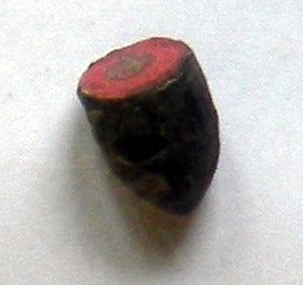Rocket Ball on:
[Wikipedia]
[Google]
[Amazon]

 The Rocket Ball was one of the earliest forms of
The Rocket Ball was one of the earliest forms of

Colette Gravity Pistol
(which have used ''Rocket Ball'' ammunition) Ammunition {{ammo-stub
metal
A metal () is a material that, when polished or fractured, shows a lustrous appearance, and conducts electrical resistivity and conductivity, electricity and thermal conductivity, heat relatively well. These properties are all associated wit ...
lic cartridge for firearms
A firearm is any type of gun that uses an explosive charge and is designed to be readily carried and operated by an individual. The term is legally defined further in different countries (see legal definitions).
The first firearms originated ...
, containing bullet
A bullet is a kinetic projectile, a component of firearm ammunition that is shot from a gun barrel. They are made of a variety of materials, such as copper, lead, steel, polymer, rubber and even wax; and are made in various shapes and constru ...
and powder
A powder is a dry solid composed of many very fine particles that may flow freely when shaken or tilted. Powders are a special sub-class of granular materials, although the terms ''powder'' and ''granular'' are sometimes used to distinguish se ...
in a single, metal-cased unit.
Construction
The Rocket Ball, patented in 1848 by Walter Hunt, consisted of alead
Lead () is a chemical element; it has Chemical symbol, symbol Pb (from Latin ) and atomic number 82. It is a Heavy metal (elements), heavy metal that is density, denser than most common materials. Lead is Mohs scale, soft and Ductility, malleabl ...
bullet with a deep hollow in the rear, running a majority of the length of the cartridge. The hollow, like that of the Minie ball, served to seal the bullet into the bore, but Rocket Ball put the cavity to further use. By packing the deep cavity with powder, and sealing it with a cap with a small hole in the rear for ignition, the Rocket Ball replaced the earlier paper cartridge
A paper cartridge is one of various types of small arms ammunition used before the advent of the cartridge (firearms), metallic cartridge. These cartridges consisted of a paper cylinder or cone containing the bullet, gunpowder, and in some case ...
with a durable package capable of being fed from a magazine. The cap was blown out of the bore upon firing. The Rocket Ball was used in magazine
A magazine is a periodical literature, periodical publication, print or digital, produced on a regular schedule, that contains any of a variety of subject-oriented textual and visual content (media), content forms. Magazines are generally fin ...
fed lever action
The toggle-link action used in the iconic Winchester Model 1873 rifle, one of the most famous lever-action firearms
Picture showing a Volcanic Pistol
A lever action is a type of action for repeating firearms that uses a manually operated coc ...
guns, allowing the first easily manufactured repeating single chamber firearms.
Use
While the Rocket Ball provided the means of making practical repeating firearms, it was not an ideal solution. The limited volume in the base of the bullet severely limited the amount of powder that could be used, and thus limited the potential velocity and range of the cartridge. Withmuzzle energy
Muzzle energy is the kinetic energy of a bullet as it is expelled from the muzzle (firearm), muzzle of a firearm. Without consideration of factors such as aerodynamics and gravity for the sake of comparison, muzzle energy is used as a rough indi ...
of only about 56 foot-pounds
The foot-pound force (symbol: ft⋅lbf, ft⋅lbf, or ft⋅lb ) is a unit of work or energy in the engineering and gravitational systems in United States customary and imperial units of measure. It is the energy transferred upon applying a ...
(76 joule
The joule ( , or ; symbol: J) is the unit of energy in the International System of Units (SI). In terms of SI base units, one joule corresponds to one kilogram- metre squared per second squared One joule is equal to the amount of work d ...
s), the Rocket Ball was less powerful than even the most feeble of modern "pocket pistol
In American English, a pocket pistol is any small, pocket-sized semi-automatic pistol (or less commonly referencing either derringers, or revolvers), and is suitable for concealed carry (USA), concealed carry in a pocket or a similar small space ...
" cartridges, such as .25 ACP and .32 ACP.
Despite these limitations, the Rocket Ball was used in a number of attempts at making a commercially successful firearm, culminating in the Volcanic Repeating Arms Company. The Volcanic cartridge went one step further, adding a primer to the cap of the Rocket Ball, making the ammunition completely self-contained.

See also
* Minie ballReferences
External links
Colette Gravity Pistol
(which have used ''Rocket Ball'' ammunition) Ammunition {{ammo-stub